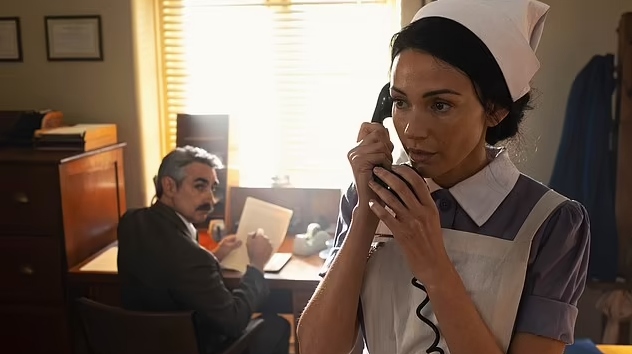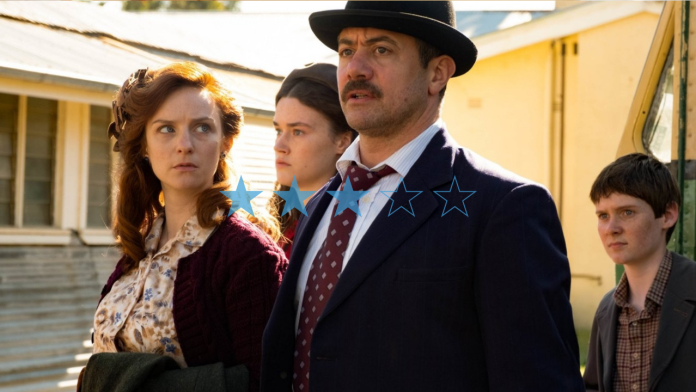For many, there’s nothing better than a Sunday night historical drama — and the BBC has provided plenty of gems over the years, from long-running family favourite Call The Midwife to the more violent but equally loved Peaky Blinders. But what about its latest period six-parter, Ten Pound Poms, which shines a light on an arguably lesser-known period of history?
★★★✰✰
Post-war Britain and the real ten pound poms
Set in 1956 post-war Britain, Ten Pound Poms is a co-production between BBC and Stan, and is produced by Eleven — the production company behind Sex Education. The show takes us back to the real-life Assisted Passage Migration Scheme — an initiative created by the Australian Chifley government in 1945. Popularly known as “10-pound poms”, the scheme ran between 1945 and 1982, promising Brits a life of sunny beaches and better working conditions for only a tenner. The catch: you had to stay for two years — or pay the return journey, which would have cost around £120 — equivalent to around £4,000 today.
While the scheme’s propaganda promised a better quality of life, many migrants were met with poor living conditions and considerable culture shocks. Most were processed and sent to migrant hostels and complexes with small corrugated iron prefabricated shelters — not the big houses with gardens from the posters. However, as this Australian Guardian article notes, there were positives. Often, women found better employment opportunities, and the weather and landscapes were a far cry from dreary post-war Britain. People also met future partners and eventually saw Australia as their new home. While an estimated quarter of British migrants returned to the UK within the first two years, half of these – the “Boomerang Poms” – returned to Australia.
A character driven drama
Ten Pound Poms is largely about the characters. So it makes sense the show’s writer, Danny Brocklehurst (Brassic, Ordinary Lies), called it “unashamedly a character drama.” The writer told the BBC: “I mean it’s got thriller moments and emotional high stakes, but it’s essentially about ordinary people in extraordinary circumstances, their lives and their families and trying to make things work.”
Our way into the story is through the Roberts family — Annie (Faye Marsay), the doting, practical wife, and Terry (Warren Brown), the alcohol-reliant husband who is full of empty promises to his family, and who, like, most war veterans, is deeply affected by what he has witnessed. We also have the two children — headstrong, intelligent Pattie (Hattie Hook) and her shy little brother Peter (Finn Treacy), who prefers birds to people. These two young Australian actors deserve acknowledgement and praise for their incredibly authentic Manchester accents.
The roles are well-cast, and you find yourself rooting for what the family desperately wants: a fresh start. It’s evident very quickly, however, that the Roberts family have a long journey ahead of them — rougher and longer than the one they took by sea to get to Australia in the first place. Terry is treated horrifically by the Australian labourers he works alongside, and he quickly finds himself resorting to old ways to fit in at work — and to escape the war horrors he relives every day. At work, he befriends Ron (Rob Collins), a fellow war veteran and Indigenous Australian, who is treated even worse than Terry. Ron’s character acts as a link between the indigenous and non-indigenous communities and highlights to audiences the degree of persecution experienced by First Nations people.
Following Terry’s involvement in an incident which almost kills a young child from Ron’s community, we see the tension and fear felt by the Indigenous community when the police storm the camp, more worried about whether there is a child there rather than their wellbeing. It was only in 1970 that the official policy of removing Aboriginal Australian children from their families and putting them into white society ended. Through stellar writing and acting, Ten Pound Poms is holistic in its storytelling, both when addressing the bigger historical picture and individual character nuance.
Another core character is Kate – a nurse played by Michelle Keegan. We are introduced to Kate the night before the ship is set to leave — alongside her fiancé, who we know is due to accompany her to a new life in Australia. However, Kate arrives the following morning at the dock by herself.

Left Wondering…
We later see Kate has administered some kind of — what at first appears lethal — injection to said fiancé and left him behind. It marks the beginning of what starts as intrigue with Kate’s character, but evolves into something more unrealistic and unbelievable. We are left confused about the fiancé’s character — Does Kate love him? Is he coercive? Does he realise Kate drugged him?
It is a similar case with Terry and Ron’s story, which ended up feeling a bit incomplete — what happened to the injured child? How was Ron able to forgive Terry?
Although incredibly poignant, Kate’s story of trying to find her child, who had been cruelly taken away several years prior, does become hard to believe. Between the 1910s and 1970, thousands of women had their children taken away and sent to Australia for reasons such as being single mothers. The show acknowledges this with accuracy and sensitivity. However, when Kate begins stealing documents and cars, kidnapping, and breaking into places left, right and centre (and getting away with it), it feels unrealistic and therefore less authentic. While Keegan’s performance does justice to how many women would have felt in such cruel circumstances, the way the storyline develops does not. Perhaps all of these holes were the result of an eagerness for Ten Pound Poms to progress beyond one season.
Incredible scenery
The landscapes we see throughout the series are breathtakingly beautiful and would make anybody want to pack it all in and move across the world. The rolling hills and mountains, beautiful beaches, blue skies and serene sunsets are done justice by the show’s seamless cinematography. While the migrant camp is claustrophobic, the rest of Australia we see is vast, and it just seems healthier. Primary parts of the series were filmed in north-west Sydney’s protected Scheyville National Park. Other locations include the Blue Mountains — a breathtakingly beautiful World Heritage region west of Sydney which spans more than 11,400 km².
Carcoar, a town in New South Wales, around three and a half hours from Sydney, was also used for filming, and it is where we see Terry endure many of his struggles. Warren Brown told Radio Times that it’s often referred to as “the town that time forgot,” which is an apt description. According to the 2016 census, only 200 people lived there, and the National Trust has also classified the town due to the number of intact buildings and cultural materials relating to 19th-century Australian life. In other words, it was a ready-made TV set.
Authentic art direction
The drama’s costume also stands out. If you are a fan of ‘50s fashion, you are likely to enjoy Ten Pound Poms’s offerings. From the incredible array of hats archetypal of the era to the countless cardigans and quaint tea dresses, do an extra layer of authenticity. In the BBC’s series preview, Rob Collins said: “Every day on set was like being transported back to the 1950s – the art direction is incredible and so authentic.” The costumes certainly played a part in this. A fashion highlight has got to be Annie’s vibrant halter cocktail dress she dons to Marlene’s cocktail party — perhaps a symbol of how far away dreary post-war Britain feels at that point in time.
The verdict
Overall, I would certainly watch a second season of Ten Pound Poms. The show highlights important issues that are still very relevant against our current political backdrop. It’s heartfelt, raw, funny, and ultimately shows us a lot about a lesser known part of history through characters we come to really care about. Ten Pound Poms might have tried to fit too many complex storylines into six episodes, but if you can take some of the plotlines with a pinch (or handful) of salt, you’ll definitely find it well worth the watch. It’s exactly what you want from a Sunday night drama.
Words by Hannah Bradfield
Support The Indiependent
We’re trying to raise £200 a month to help cover our operational costs. This includes our ‘Writer of the Month’ awards, where we recognise the amazing work produced by our contributor team. If you’ve enjoyed reading our site, we’d really appreciate it if you could donate to The Indiependent. Whether you can give £1 or £10, you’d be making a huge difference to our small team.
